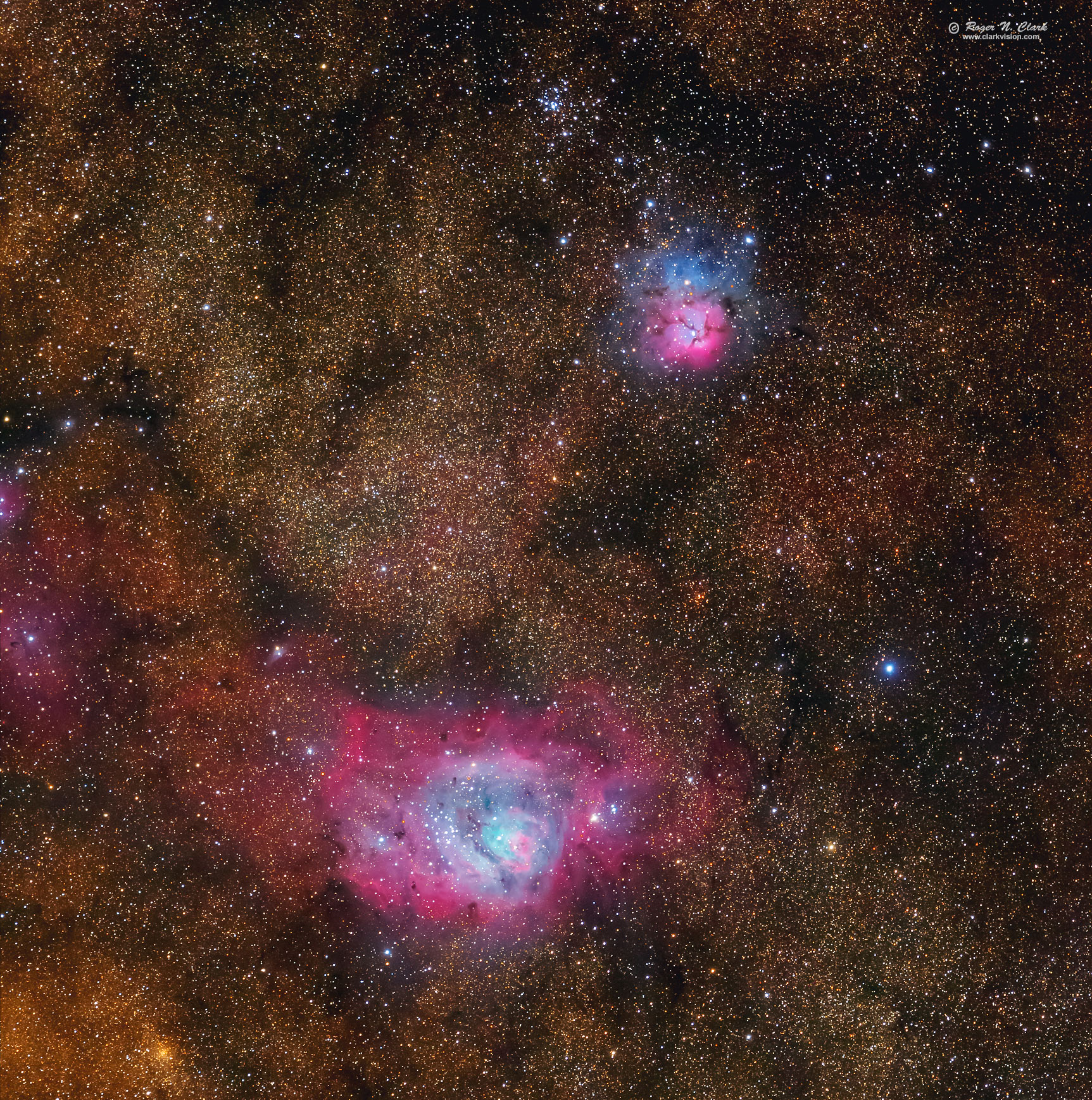| Home | Galleries | Articles | Reviews | Best Gear | New | About | Contact | Gallery Index | Previous |
Next |

| Home | Galleries | Articles | Reviews | Best Gear | New | About | Contact | Gallery Index | Previous |
Next |

M8, the Lagoon Nebula and M20, the Trifid Nebula in Sagittarius rises high in the summer for northern hemisphere observers. The nebulae are surrounded by brown dust in the Milky Way galaxy.
Technical. This image was obtained with a Canon 7D Mark II 20-megapixel digital camera and 300 mm f/2.8 L IS II lens at f/2.8 and ISO 1600. No dark frame subtraction, no flat fields. Tracking with an Astrotrac and no guiding. Nineteen minutes total exposure (19 1-minute exposures). Stars fainter than magnitude 17 were recorded.
It was a warm summer night and the camera was running at a temperature of 29 C (84 F), but the dark current at this temperature was only about 0.2 electron per second. Skies were quite bright (mainly from aurora and airglow): red = 20.7, green = 21.2, blue = 21.6 magnitudes / sq. arc-second (Bortle 5). The sensor recorded about 1.7 photons / second per pixel in green light from the magnitude 21.2 sky, thus, sky signal was more than 8 times the signal from dark current (dark current is blocked in hardware in the pixel, but noise still contributes to the sensor noise level). Thus, dark current noise from the warm sensor contributed only 6% of the total noise in the darkest areas of the image.
This is a natural color image. The high dynamic range of astrophotos must be stretched to bring out the range of details the camera recorded. But the typical image stretch process loses color for brighter subjects (e.g. stars and the brighter parts of deep sky objects become whiter as they are made brighter). This image uses a new algorithm that does not lose color during the stretch. The new algorithm enables fainter details to be shown and with less noise. Learn about the new software and download it free (open source) here: rnc-color-stretch.
Post processing: stretched with rnc-color-stretch. Also see Astrophotography Image Processing Basic Work Flow.
The Exposure Factors, CEF, CEFA are measures of the relative amounts of light received from a subject. It can be used to fairly compare wildly different lens/telescope apertures and exposure times. For this image:
Modern DSLRs like the 7D Mark II include on sensor dark current suppression and low fixed pattern noise at ISOs around 1600 and higher, making no need for dark frame subtraction. Modern raw converters correct for light fall-off and also correct for hot/dead/stuck pixels. This makes processing low light images easy: simply align and average.
To learn how to obtain stunning images like this, please visit my Extensive Articles on Photography .
See my review of the Canon 7D Mark II and why it is so good for astrophotography: Canon 7D Mark II sensor analysis.
Keywords to this image = astrophoto-1 nebula Messier low-light digital_astro canon_7d2 rnc-color-stretch
Image ID: m8+m20.rnclark.c08.12.2015.19frames-t4rs50-d-0.5x-c1s.jpg
| Home | Galleries | Articles | Reviews | Best Gear | Science | New | About | Contact |
Last updated December 20, 2025